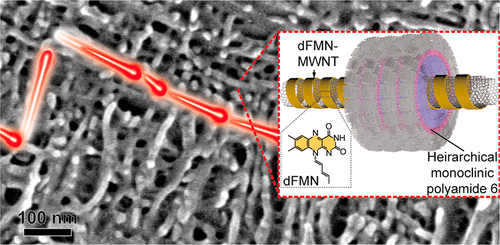Our official English website, www.x-mol.net, welcomes your
feedback! (Note: you will need to create a separate account there.)
Flavin Mononucleotide-Mediated Formation of Highly Electrically Conductive Hierarchical Monoclinic Multiwalled Carbon Nanotube-Polyamide 6 Nanocomposites.
ACS Nano ( IF 15.8 ) Pub Date : 2020-08-03 , DOI: 10.1021/acsnano.0c05170
Minsuk Park 1 , Seulki Yoon 2 , Junmo Park 1 , No-Hyung Park 3 , Sang-Yong Ju 1
ACS Nano ( IF 15.8 ) Pub Date : 2020-08-03 , DOI: 10.1021/acsnano.0c05170
Minsuk Park 1 , Seulki Yoon 2 , Junmo Park 1 , No-Hyung Park 3 , Sang-Yong Ju 1
Affiliation

|
Although the multiwalled carbon nanotube (MWNT) is a promising material for use in the production of high electrical conductivity (σ) polymer nanocomposites, its tendency to aggregate and distribute randomly in a polymer matrix is a problematic issue. In the current study, we developed a highly conductive and monoclinically aligned MWNT-polyamide 6 (PA) nanocomposite containing interfacing flavin moieties. In this system, the flavin mononucleotide (FMN) initially serves as a noncovalent aqueous surfactant for individualizing MWNTs in the form of FMN-wrapped MWNTs (FMN-MWNT), and then partially decomposed FMN (dFMN) induces crystallization of the PA on the MWNTs. The results of experiments performed using material subjected to partial dissolution of PA matrix show that the nanocomposite PA-dFMN-MWNT, formed by melt extrusion of PA and dFMN-MWNT, contains a three-dimensional monoclinic MWNT network embedded in an equally monoclinic PA matrix. An increase in monoclinic network promoted by an increase in the content of MWNT increases σ of the nanocomposite up to 100 S/m, the highest value reported for a polymer-MWNT nanocomposite. X-ray diffraction along with transmission electron microscopy reveal that the presence of dFMN induces the formation of monoclinic PA on dFMN-MWNT. The high σ of the PA-dFMN-MWNT nanocomposite is also a consequence of a minimization of defect formation of MWNT by noncovalent functionalization. Hierarchical structural ordering, yet individualization of MWNTs, provides a viable strategy to improve the physical property of nanocomposites.
中文翻译:

黄素单核苷酸介导的高导电分层单斜多壁碳纳米管-聚酰胺6纳米复合材料的形成。
尽管多壁碳纳米管(MWNT)是用于生产高电导率(σ)聚合物纳米复合材料的有前途的材料,但其在聚合物基质中随机聚集和分布的趋势仍然是一个问题。在当前的研究中,我们开发了一种高导电性和单临床排列的包含界面黄素部分的MWNT-聚酰胺6(PA)纳米复合材料。在该系统中,黄素单核苷酸(FMN)最初用作非共价水性表面活性剂,用于以FMN包裹的MWNT(FMN-MWNT)的形式个体化MWNT,然后部分分解的FMN(dFMN)引起MWNT上PA的结晶。使用PA基质部分溶解的材料进行的实验结果表明,通过PA和dFMN-MWNT熔融挤出形成的纳米复合材料PA-dFMN-MWNT,包含嵌入在同等单斜PA矩阵中的三维单斜MWNT网络。MWNT含量的增加促进了单斜网络的增加,使纳米复合材料的σ增加到100 S / m,这是聚合物MWNT纳米复合材料报道的最高值。X射线衍射以及透射电子显微镜显示dFMN的存在诱导了dFMN-MWNT上单斜晶PA的形成。PA-dFMN-MWNT纳米复合材料的高σ也是由于非共价官能化使MWNT缺陷形成最小化的结果。MWNTs的分层结构有序但又个性化,为提高纳米复合材料的物理性能提供了可行的策略。MWNT含量的增加促进了单斜网络的增加,使纳米复合材料的σ增加到100 S / m,这是聚合物MWNT纳米复合材料报道的最高值。X射线衍射以及透射电子显微镜显示dFMN的存在诱导了dFMN-MWNT上单斜晶PA的形成。PA-dFMN-MWNT纳米复合材料的高σ也是非共价官能化使MWNT缺陷形成最小化的结果。MWNTs的分层结构有序但又个性化,为提高纳米复合材料的物理性能提供了可行的策略。MWNT含量的增加促进了单斜网络的增加,使纳米复合材料的σ增加到100 S / m,这是聚合物MWNT纳米复合材料报道的最高值。X射线衍射以及透射电子显微镜显示dFMN的存在诱导了dFMN-MWNT上单斜晶PA的形成。PA-dFMN-MWNT纳米复合材料的高σ也是由于非共价官能化使MWNT缺陷形成最小化的结果。MWNTs的分层结构有序但又个性化,为提高纳米复合材料的物理性能提供了可行的策略。X射线衍射以及透射电子显微镜显示dFMN的存在诱导了dFMN-MWNT上单斜晶PA的形成。PA-dFMN-MWNT纳米复合材料的高σ也是由于非共价官能化使MWNT缺陷形成最小化的结果。MWNTs的分层结构有序但又个性化,为提高纳米复合材料的物理性能提供了可行的策略。X射线衍射以及透射电子显微镜显示dFMN的存在诱导了dFMN-MWNT上单斜晶PA的形成。PA-dFMN-MWNT纳米复合材料的高σ也是由于非共价官能化使MWNT缺陷形成最小化的结果。MWNTs的分层结构有序但又个性化,为提高纳米复合材料的物理性能提供了可行的策略。
更新日期:2020-08-25
中文翻译:

黄素单核苷酸介导的高导电分层单斜多壁碳纳米管-聚酰胺6纳米复合材料的形成。
尽管多壁碳纳米管(MWNT)是用于生产高电导率(σ)聚合物纳米复合材料的有前途的材料,但其在聚合物基质中随机聚集和分布的趋势仍然是一个问题。在当前的研究中,我们开发了一种高导电性和单临床排列的包含界面黄素部分的MWNT-聚酰胺6(PA)纳米复合材料。在该系统中,黄素单核苷酸(FMN)最初用作非共价水性表面活性剂,用于以FMN包裹的MWNT(FMN-MWNT)的形式个体化MWNT,然后部分分解的FMN(dFMN)引起MWNT上PA的结晶。使用PA基质部分溶解的材料进行的实验结果表明,通过PA和dFMN-MWNT熔融挤出形成的纳米复合材料PA-dFMN-MWNT,包含嵌入在同等单斜PA矩阵中的三维单斜MWNT网络。MWNT含量的增加促进了单斜网络的增加,使纳米复合材料的σ增加到100 S / m,这是聚合物MWNT纳米复合材料报道的最高值。X射线衍射以及透射电子显微镜显示dFMN的存在诱导了dFMN-MWNT上单斜晶PA的形成。PA-dFMN-MWNT纳米复合材料的高σ也是由于非共价官能化使MWNT缺陷形成最小化的结果。MWNTs的分层结构有序但又个性化,为提高纳米复合材料的物理性能提供了可行的策略。MWNT含量的增加促进了单斜网络的增加,使纳米复合材料的σ增加到100 S / m,这是聚合物MWNT纳米复合材料报道的最高值。X射线衍射以及透射电子显微镜显示dFMN的存在诱导了dFMN-MWNT上单斜晶PA的形成。PA-dFMN-MWNT纳米复合材料的高σ也是非共价官能化使MWNT缺陷形成最小化的结果。MWNTs的分层结构有序但又个性化,为提高纳米复合材料的物理性能提供了可行的策略。MWNT含量的增加促进了单斜网络的增加,使纳米复合材料的σ增加到100 S / m,这是聚合物MWNT纳米复合材料报道的最高值。X射线衍射以及透射电子显微镜显示dFMN的存在诱导了dFMN-MWNT上单斜晶PA的形成。PA-dFMN-MWNT纳米复合材料的高σ也是由于非共价官能化使MWNT缺陷形成最小化的结果。MWNTs的分层结构有序但又个性化,为提高纳米复合材料的物理性能提供了可行的策略。X射线衍射以及透射电子显微镜显示dFMN的存在诱导了dFMN-MWNT上单斜晶PA的形成。PA-dFMN-MWNT纳米复合材料的高σ也是由于非共价官能化使MWNT缺陷形成最小化的结果。MWNTs的分层结构有序但又个性化,为提高纳米复合材料的物理性能提供了可行的策略。X射线衍射以及透射电子显微镜显示dFMN的存在诱导了dFMN-MWNT上单斜晶PA的形成。PA-dFMN-MWNT纳米复合材料的高σ也是由于非共价官能化使MWNT缺陷形成最小化的结果。MWNTs的分层结构有序但又个性化,为提高纳米复合材料的物理性能提供了可行的策略。

































 京公网安备 11010802027423号
京公网安备 11010802027423号